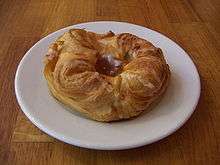Danish pastry
English

A glazed apple Danish pastry.
Etymology
So named because they were introduced to the United States via Copenhagen.[1]
Noun
Danish pastry (plural Danish pastries)
- A sweet and flaky yeast-raised roll made from a dough using butter or margarine and filled with remonce (butter and sugar) or custard.
- Synonym: Danish
- Hypernym: viennoiserie
- Coordinate term: croissant
- 2004, Harold McGee, chapter 10, in On Food and Cooking: The Science and Lore of the Kitchen, Scribner, →ISBN:
- Danish pastries are made in essentially the same way as croissants. The initial dough is moister and softer, includes sugar and also whole eggs, so it's sweeter, richer, and distinctively yellow, and it isn't given an initial rising.
Translations
yeast roll
|
Further reading

References
- Harold McGee (2004), chapter 10, in On Food and Cooking: The Science and Lore of the Kitchen (in English), Scribner, →ISBN: “What Americans call “Danish” pastries also originated in Vienna goods, but were introduced to the United States via Copenhagen. In the 19th century, Danish bakers took a basic Viennese enriched bread dough and added even more layering butter, thus making a lighter, crisper pastry than the original.”
This article is issued from
Wiktionary.
The text is licensed under Creative
Commons - Attribution - Sharealike.
Additional terms may apply for the media files.